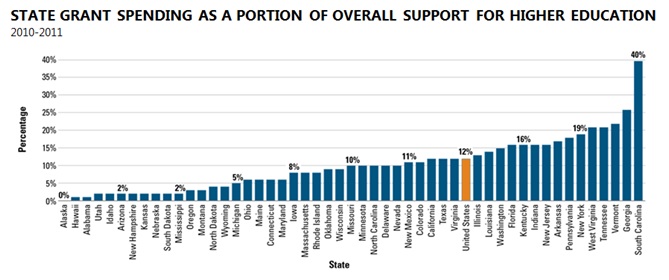In a previous post, we review how federal grants –mainly the Pell Grant program- help low-income students offset some of the cost of higher education. However, large gaps remain between the cost of attendance and a full Pell Grant, particularly at universities.
What can be done to minimize the difference between the cost of attending a university and federal support? State-funded financial aid can play an important role in helping students of all ages access financial support needed to attend college.
The chart below shows data from the College Board on Mississippi’s spending on state grant programs as a percentage of our overall spending on higher education. Nationwide, states allocated grant funds equal to 12% of overall support for higher education. In contrast, Mississippi spent an amount equal to 2% of higher education spending on state aid in 2011. Arkansas, Louisiana, Tennessee, Texas, Georgia, and South Carolina all spent a larger portion of funds on state grant aid than Mississippi.
Mississippi also ranks below average for its state appropriations to higher education grant programs where the financial need of the student is considered. Across the country 71% of the grant aid distributed by states considers the financial needs of students. In Mississippi, 15% of the grant programs are allocated on the basis of need. In Mississippi, 1 in 3 youth grow up in the conditions of poverty- a higher prevalence than youth nationally. The relatively low portion of state grant funding that screens for the financial needs of students potentially lifts up the need to increase and adapt the state’s current financial aid programs.
The level at which we fund state financial aid and the portion of funds directed on the basis of financial need also affect students’ levels of loan borrowing as they pursue a degree. Stay tuned. Upcoming blogs will take a closer look at student loan borrowing and default rates for Mississippi students.
Source: Baum, Sandy and and Kathleen Payea. 2012. Trends in Student Aid. College Board Advocacy and Policy Center. http://trends.collegeboard.org/sites/default/files/student-aid-2012-full-report-130201.pdf
Sarah Welker, Senior Policy Analyst






